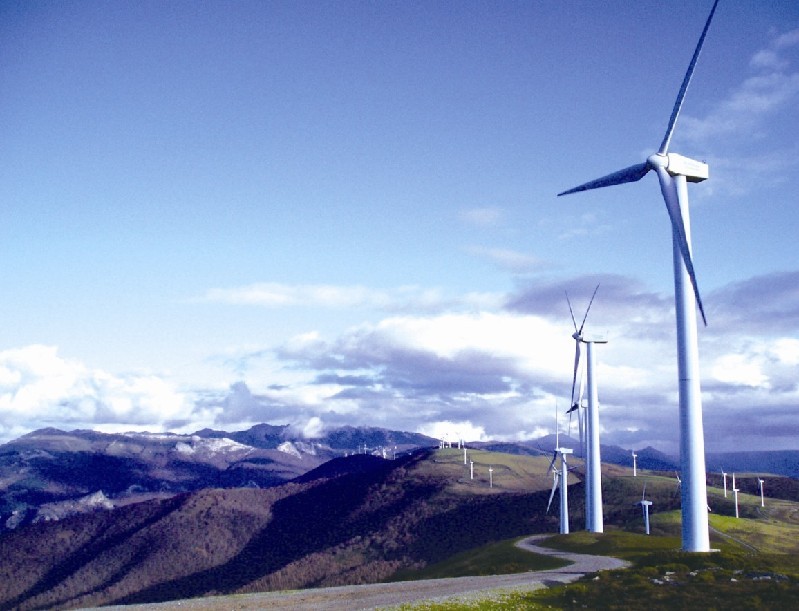Europe Germany's energy transformation
欧洲 德国的能源转型
Energiewende
能源大变身
German plans to cut carbon emissions with renewable energy are ambitious, but they are also risky
德国计划通过可再生能源削减碳排放。雄伟的能源计划风险犹存。
“The quieter the evening, the more you hear it,” says Wilfried Bockholt, mayor of Niebull in North Friesland. He mimics the sound of a 55-metre-long rotor whirling round a windmill’s mast. He is a driving force behind the “citizens’ wind park”, but he has mixed feelings. A region famed for broad horizons is now jagged with white spires. “They alter the landscape completely,” he laments.
北弗里兰县的尼必尔市市长Wilfried Bockholt说,“夜愈是寂静,风车的声音就愈震耳。”他随即模仿了长达5米的风车翼片在桅杆上急速旋转的声音。Bockholt是“市民风电场”背后的推动力量,然而于此项目,他却是喜忧参半。曾以视野广阔盛名的尼必尔,现今却挤满了高低起伏的白风车。他抱怨道,“风车完全改变了这儿的地形。”

North Friesland’s wind boom is part of Germany’s Energiewende (energy transformation), a plan to shift from nuclear and fossil fuels to renewables. It was dreamed up in the 1980s, became policy in 2000 and sped up after the Fukushima disaster in March 2011. That led Angela Merkel, the chancellor, to scrap her extension of nuclear power (rather than phasing it out by 2022, as previous governments had planned). She ordered the immediate closure of seven reactors. Germany reaffirmed its clean-energy goals—greenhouse-gas emissions are to be cut from 1990 levels by 40% by 2020 and by 80% by 2050—but it must now meet those targets without nuclear power.
北弗里兰县蓬勃发展的风力是德国能源转型计划的一部分,该计划旨在将德国利用的能源从核能、矿物燃料转变为可再生能源。能源转型计划构想于上世纪80年代,于2000年出台相关政策,并在2011年3月福岛灾难发生后加快了政策进程。上届政府曾计划在2022年前彻底废除核能,而福岛事故促使现任总理安吉拉·默克尔改变对扩大发展核能的态度。她下令立即关闭7座核反应堆。德国重申了本国的清洁能源计划,即在2020年和2050年,温室气体排放量分别比1990年减少40%和80%,但如今德国需在不利用核能的情况下完成目标。
The rest of the world watches with wonder, annoyance—and anticipatory Schadenfreude. Rather than stabilising Europe’s electricity, Germany plagues neighbours by dumping unpredictable surges of wind and solar power. To many theEnergiewende is a lunatic gamble with the country’s manufacturing prowess. But if it pays off Germany will have created yet another world-beating industry, say the gamblers. Alone among rich countries Germany has “the means and will to achieve a staggering transformation of the energy infrastructure”, says Mark Lewis, an analyst at Deutsche Bank.
其他国家看德国的眼神里带有一丝惊奇,些许厌恶,幸灾乐祸。德国理应维护欧洲供电的稳定,现今却用廉价出售琢磨不定的风能、太阳能给邻国添堵。对多数人而言,能源转型计划就是用德国强大的制造业来进行一场疯狂的赌博。然而一旦有所回报,德国将创建另一个世界级行业,“赌徒们”如是说。在所有发达国家中,德国是唯一“有方法、有决心完成能源基础设施交错转型”的国家,德意志银行的分析师Mark Lewis说道。
Much could go wrong. Wholesale electricity prices will be 70% higher by 2025, predicts the Karlsruhe Institute of Technology. Germany must build or upgrade 8,300km (5,157 miles) of transmission lines (not including connections to offshore wind farms). Intermittent wind and sun power creates a need for backup generators, while playing havoc with business models that justify investing in them. Hans-Peter Keitel, president of the Federation of German Industry, likens theEnergiewende to “open-heart surgery”.
仍有很多地方会出现差池。据卡尔斯鲁厄理工学院预测,截至2025年,发电成本将整体上涨70%。德国必须修建或升级8300千米(5157英里)的电力传输线,其中不包括将海上风电站连到电网的线路。风能、太阳能的间接性在搅乱专为其投资建立的商业模型的同时,也产生了对备用发电机组的需求。德国工业联合会主席Hans-Peter Keitel就将能源转型计划比作“开胸手术”
In May Mrs Merkel sacked the environment minister, Norbert Rottgen, after he led her Christian Democrats to a disastrous defeat in a regional election. His successor is Peter Altmaier, a canny parliamentarian who will share responsibility with the economy minister, Philipp Rosler. In fact Mrs Merkel has taken charge herself. She convenes energy summits with leaders of the 16 states, and promises to incorporate grid operators’ plans into federal law by the end of the year. But even she admits the Energiewende is a “Herculean task”.
今年五月,Norbert Rottgen代表基民盟竞选州长失败,默克尔随后解除了其环境部长职位,并任命精明谨慎的国会议员Peter Altmaier接任。Altmaier将同财政部长Philipp Rosler共担重任。事实上,默克尔早已亲自接管此事。她召集16个州的州长举行州长能源峰会,并向各州长保证,将会在今年年底前,把电网运营商的计划纳入联邦法律。但就连她自己也不得不承认能源转型计划是一项异常艰巨的任务。 翻译:王葭苇













